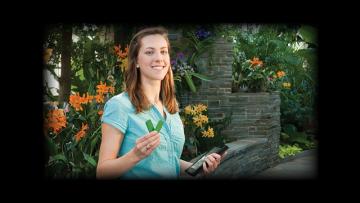Bringing Gardens to Bloom for the Blind: VCU School of Engineering Makes it Real
by guest bloggers Ruth Intress and Nan Johnson, originally published on WCVE’s Science Matters blog
The colors, textures and landscaping at Richmond’s Lewis Ginter Botanical Garden is all but hidden from people who are blind and visually impaired. But not for long. Christina Walinski, a Virginia Commonwealth University Engineering student and her professor, Dianne T.V. Pawluk, Ph.D., are creating a wireless device that could aid those with impaired vision to better experience the garden on their own.
The project began when Beth Tippett, Volunteer Garden Guide at Lewis Ginter Botanical Garden, approached Pawluk, an associate professor in VCU’s Biomedical Engineering Department and an expert in developing devices and software programs for assistive technology applications for people who are blind and visually impaired. Pawluk saw an opportunity for a senior design project. Walinski, one of Pawluk’s former rehabilitation engineering students, now a senior, was the ideal candidate.
“I love nature,” Walinski said. “The opportunity to share nature with others through a wireless device is a demonstration of my engineering education.” With Pawluk’s guidance, she is honing her concept of a wireless garden device that would use radio frequency identification (RFID) and its electromagnetic fields to transfer data from a tag to an RFID reader. This technology would allow an individual to listen to pre-programmed information about plants and flowers.
“We are looking at creating an application for a hand-held, auditory-based device that uses radio frequency identification with tags placed in key locations in the garden,” said Pawluk. “The successful design of this prototype has the potential to make a difference in the lives of blind and visually impaired people.”
Making a difference also is a goal for the garden, said Randee Humphrey, Director of Education at Lewis Ginter Botanical Garden. “A device that could allow us to share our garden with people who are blind and visually impaired is aligned with the garden’s education mission and our passion for connecting people and plants to improve our community,” said Humphrey. “This is one of several partnerships between the garden andVCU and we’re grateful to the university for sharing its expertise.” Currently, garden staff is working on recordings for the auditory tour portion, as well as determining which elements of the garden are the best suited for this project.
Within the next few weeks, Walinski will design an application using Java programming language with Android, an operating system designed for smartphones, for the navigational component of the auditory tour. The application will also allow Lewis Botanical Garden staff to create updates as garden scenery changes.Walinski is currently testing RFID tag placement and the effects of tag orientation in key garden locations. The goal is to have tags that can be read within a three-to-five foot range.
“I’m excited to use the concepts I’ve learned in my engineering curriculum to develop a technology that has the potential to positively impact many members of our Richmond community,” said Walinski.
“I’ll be delivering the prototype auditory tour to the Lewis Ginter Botanical Garden this spring,” added Walinski. “I’m thrilled to see them offer the tour to individuals who are visually impaired as well as anyone else wishing to experience more of the garden.”
Walinski’s prototype will be one of 67 projects featured at the Senior Design Expo, April 19 at the Science Museum of Virginia. The Senior Design Expo is free and open to the public.
